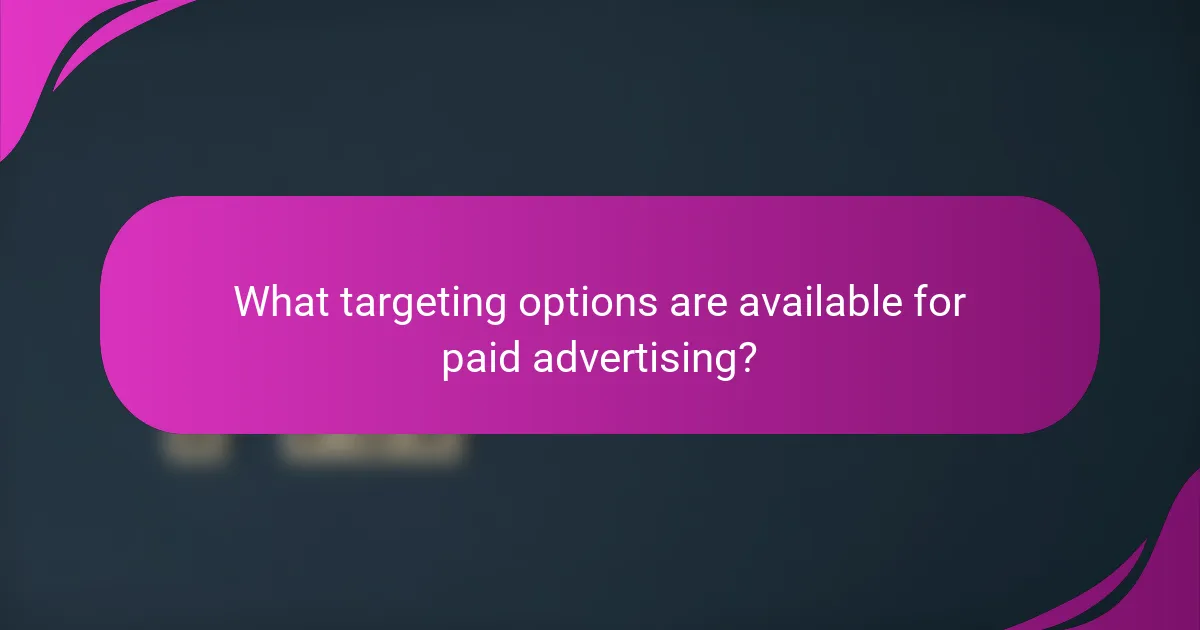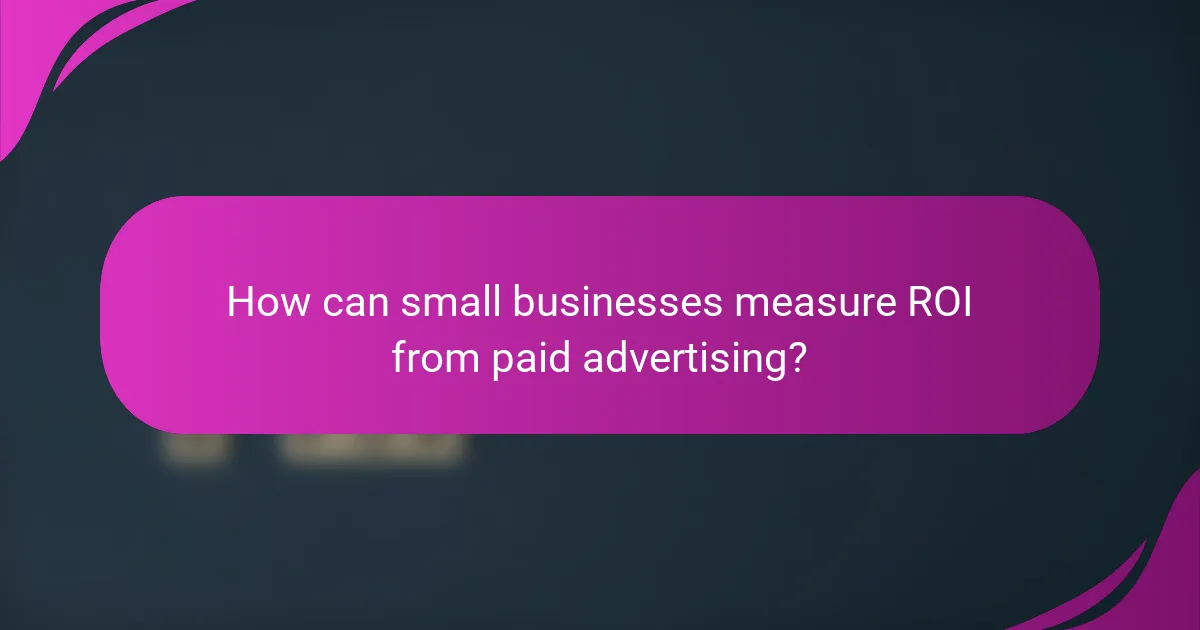For small businesses, effective budgeting for paid advertising is crucial to ensure that marketing expenses align with revenue and maximize returns. By leveraging various targeting options, such as demographic and interest-based targeting, businesses can reach their ideal audiences more effectively. Choosing the right advertising platforms, like Google Ads or social media channels, further enhances the potential for achieving specific marketing goals and improving overall ROI.

How can small businesses budget for paid advertising in South Africa?
Small businesses in South Africa can effectively budget for paid advertising by determining a clear percentage of their revenue, utilizing historical data, and considering industry benchmarks. This approach ensures that advertising expenses align with financial capabilities while maximizing potential returns.
Setting a percentage of revenue
A common method for budgeting is to allocate a specific percentage of revenue to advertising. Many small businesses set aside around 5% to 10% of their gross revenue for this purpose. This percentage can be adjusted based on growth objectives or market conditions.
For instance, a business generating ZAR 1 million in revenue might budget ZAR 50,000 to ZAR 100,000 for advertising. This method provides a straightforward way to scale advertising efforts as revenue grows.
Using historical data for projections
Analyzing past advertising performance can guide future budget decisions. By reviewing previous campaigns, businesses can identify which strategies yielded the best return on investment (ROI) and allocate funds accordingly. Historical data helps in estimating the cost of acquiring new customers.
For example, if a campaign that cost ZAR 20,000 resulted in 200 new customers, the business can project similar costs for future campaigns, adjusting the budget based on expected outcomes.
Considering industry benchmarks
Understanding industry benchmarks can provide valuable context for budgeting. Different sectors have varying average advertising spends; for example, retail businesses might spend more on advertising compared to service-based industries. Researching these benchmarks helps small businesses set realistic budgets.
For instance, if the average advertising spend in a specific industry is around 8% of revenue, a small business can use this information to justify its budget decisions and remain competitive.
Allocating funds for seasonal promotions
Seasonal promotions can significantly boost sales, making it essential to allocate specific funds for these periods. Businesses should identify peak seasons relevant to their products or services and plan advertising budgets accordingly. This ensures that they can capitalize on increased consumer spending during these times.
For example, a small retail store might increase its advertising budget by 20% during the holiday season to attract more customers, ensuring they are visible in a crowded market.
Adjusting budget based on campaign performance
Monitoring campaign performance is crucial for effective budget management. Small businesses should regularly review the effectiveness of their advertising efforts and adjust budgets based on what is working. This agile approach allows businesses to reallocate funds to high-performing campaigns.
For instance, if a digital campaign generates a higher ROI than expected, increasing its budget can amplify results. Conversely, underperforming campaigns should be reassessed or scaled back to optimize overall spending.

What targeting options are available for paid advertising?
Paid advertising offers various targeting options to help businesses reach specific audiences effectively. These options include demographic, geographic, interest-based, behavioral targeting, and retargeting, each designed to enhance ad relevance and improve return on investment (ROI).
Demographic targeting
Demographic targeting allows advertisers to reach audiences based on characteristics such as age, gender, income level, and education. This method is effective for tailoring messages that resonate with specific groups, increasing engagement and conversion rates.
For example, a luxury brand may focus on high-income individuals aged 30-50, while a children’s toy company might target parents aged 25-40. Understanding your target demographics helps in crafting ads that appeal directly to their needs and preferences.
Geographic targeting in South Africa
Geographic targeting enables businesses to focus their advertising efforts on specific locations, which is particularly useful for local businesses. In South Africa, this can include targeting by province, city, or even neighborhoods to ensure ads reach the most relevant audience.
For instance, a restaurant in Cape Town may target users within a 10-kilometer radius, while a national retailer might focus on major urban centers. This approach helps optimize ad spend by reaching potential customers who are more likely to visit or purchase.
Interest-based targeting
Interest-based targeting involves showing ads to users based on their interests, hobbies, and online behaviors. This type of targeting leverages data from social media platforms and browsing history to identify users who are likely to be interested in specific products or services.
For example, a fitness brand might target users who follow health and wellness pages, while a travel agency could focus on individuals who frequently search for travel-related content. This method increases the chances of engagement by aligning ads with users’ passions.
Behavioral targeting
Behavioral targeting focuses on users’ past online behavior, such as websites visited, content consumed, and interactions with previous ads. This method helps advertisers understand user intent and tailor ads accordingly, increasing the likelihood of conversion.
For instance, if a user frequently visits sites related to home improvement, they may see ads for tools or renovation services. This targeted approach can significantly enhance ad effectiveness by reaching users who have already shown interest in similar products.
Retargeting previous website visitors
Retargeting allows businesses to show ads to users who have previously visited their website but did not convert. This strategy keeps the brand top-of-mind and encourages potential customers to return and complete their purchase.
For example, if a user browses a specific product but leaves the site, retargeting ads can remind them of that product as they browse other sites. This method can lead to higher conversion rates, as it targets users who have already expressed interest in the brand.

What are the best platforms for paid advertising?
The best platforms for paid advertising depend on your target audience and business goals. Google Ads, Facebook, Instagram, LinkedIn, and Twitter each offer unique advantages for reaching specific demographics and achieving various marketing objectives.
Google Ads for search visibility
Google Ads is ideal for businesses seeking to enhance their search visibility. By bidding on relevant keywords, you can display ads to users actively searching for products or services like yours. This platform operates on a pay-per-click model, meaning you only pay when someone clicks your ad.
Consider starting with a budget of a few hundred dollars per month to test different keywords and ad formats. Monitor your campaigns closely to optimize performance and adjust bids based on what drives the best results.
Facebook Ads for social engagement
Facebook Ads excel at fostering social engagement and building brand awareness. With detailed targeting options based on user interests, demographics, and behaviors, you can reach specific audiences effectively. Ads can appear in users’ news feeds, stories, or sidebars.
For small businesses, a budget of around $5 to $20 per day can yield significant engagement. Experiment with various ad formats, such as carousel or video ads, to see what resonates best with your audience.
Instagram Ads for visual appeal
Instagram Ads are perfect for brands that rely on visual storytelling. This platform allows you to showcase products through eye-catching images and videos, making it ideal for fashion, food, and lifestyle brands. Ads can be integrated into users’ feeds or stories.
Starting with a budget similar to Facebook Ads can be effective, as both platforms share the same advertising system. Focus on high-quality visuals and engaging captions to capture attention and drive conversions.
LinkedIn Ads for B2B targeting
LinkedIn Ads are tailored for B2B marketing, making them suitable for companies targeting professionals and decision-makers. You can create sponsored content, text ads, or InMail campaigns to reach specific industries or job titles.
Investing a minimum of $10 per day can help you gain visibility among a professional audience. Utilize LinkedIn’s targeting features to refine your audience based on company size, industry, and job function for optimal results.
Twitter Ads for real-time engagement
Twitter Ads are effective for real-time engagement and promoting timely content. This platform allows you to reach users through promoted tweets, trends, and accounts, making it suitable for events or news-related campaigns.
A budget of $50 to $100 can help you test different ad formats and reach a broader audience. Focus on crafting concise, engaging messages that encourage retweets and interactions to maximize your campaign’s impact.

How can small businesses measure ROI from paid advertising?
Small businesses can measure ROI from paid advertising by analyzing the revenue generated from ads against the total cost of those ads. This involves tracking conversions, calculating customer acquisition costs, and using analytics tools to assess performance over time.
Tracking conversions through Google Analytics
Tracking conversions is essential for understanding the effectiveness of paid advertising. Google Analytics allows businesses to set up goals that represent key actions, such as purchases or sign-ups, which can be linked to specific ad campaigns.
To track conversions, set up conversion tracking in Google Analytics by creating goals based on desired user actions. Monitor the conversion rate, which is the percentage of visitors who complete a goal, to evaluate ad performance. A good conversion rate typically ranges from 2% to 5%, depending on the industry.
Calculating customer acquisition cost
Customer acquisition cost (CAC) is the total cost of acquiring a new customer through advertising efforts. To calculate CAC, divide the total advertising spend by the number of new customers gained during a specific period.
For example, if a business spends $1,000 on ads and gains 50 new customers, the CAC would be $20. Keeping CAC low is crucial; aim for a CAC that is significantly lower than the lifetime value of a customer to ensure profitability.


